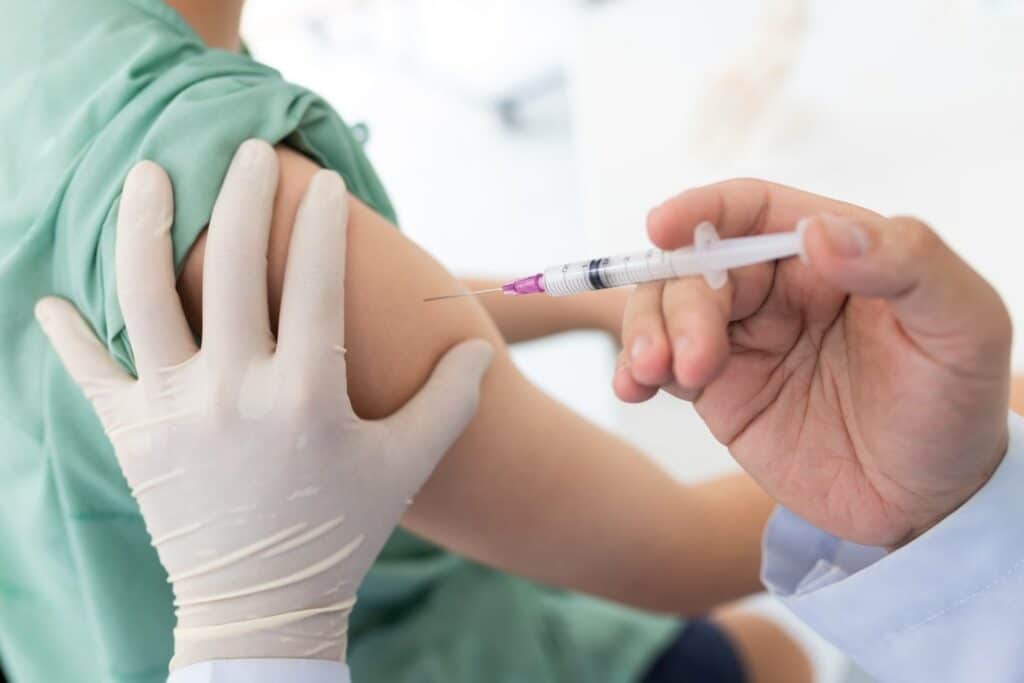MUMPS & RUBELLA: HOW VACCINES VIRTUALLY ELIMINATED THESE ONCE DEADLY DISEASES
MicroCE, Pete Kreckel, 0.25 hours
Mumps and rubella are diseases that have been virtually eliminated by vaccines. All of the vaccines we pharmacists administer provide direct benefit to the patient who receives them.
Rubella vaccine shows direct benefit to the unborn child. All of society gets vaccinated against rubella, but the benefit is for the unborn.
Table of Contents
An estimated 212,000 cases of mumps occurred in 1964, and I would have been one of them, as a kid in kindergarten. I remember the swollen glands, but best of all I remember being out of school for a couple of weeks! It was amazing how mumps, measles, chickenpox and colds spread through our families.
Mumps
Causative agent: Mumps is a caused by a paramyxovirus, a member of the rubulavirus family. It has a single-stranded viral genome. The average incubation period for mumps is 16 to 18 days. The peak incidence for mumps is late winter to early spring but can occur any time of the year.
It was first described by Hippocrates in the fifth century BC. 95% of adults had tested positive to prior exposure to mumps, indicating that nearly all people are eventually infected in unvaccinated populations. The R naught value for mumps is between 10-12, which is 10 times greater than influenza.
Symptoms:
Mumps typically starts with generalized symptoms such as fever, headache, muscle aches, tiredness, and loss of appetite for a few days. Patients progress to parotitis (inflammation of the parotid glands) which are salivary glands located in the front, below the ears. This lasts for about 5 days and resolves by day 10.
Complications:
Usually occur in the adult population
- Meningitis or encephalitis: Before the vaccine was available 10% of viral meningitis cases were caused by mumps
- Orchitis (inflammation of one or both testicles)
- Happens in about 10% of post pubertal males
- Mastitis (inflammation of breast tissue)
- Parotitis (inflammation of one or both parotid glands)
- Parotitis occurs only in 31% to 65% of individuals infected with mumps. From 15% to 27% of people with mumps have no signs or symptoms of illness.
- Oophoritis (inflammation of one or both ovaries)
- Pancreatitis (inflammation of the pancreas)
- Deafness
- occurs in 1:20,000 cases, and once was a major cause of deafness in children.
Prevalence:
United States Mumps cases
As of October 28, 2022, a total of 215 mumps cases were reported in the USA. Texas had the highest number of mumps cases with 21.
In the past 20 years, here are the years that had over 6000 cases:
- 2006: 6584 cases
- 2016: 6369 cases
- 2017: 6109 cases
During World War I, only influenza and gonorrhea were more common than mumps as causes of hospitalization among soldiers.
RUBELLA (GERMAN MEASLES)
In 2004 Rubella, more commonly known as German measles, was eliminated from the United States. Despite our success in the United States, the World Health Organization (WHO) reports that over 100,000 children worldwide have congenital rubella syndrome (CRS).
Rubella which translated means “little red” was first lumped in with scarlet fever or measles. It first appeared in German literature as its separate disease and was given the vernacular name “German measles.” Rubella virus is the only member of the genus rubivirus, in the family matonaviridae. It is an enveloped virus with a single-stranded RNA and having a single antigenic type. There are no animal reservoirs, and humans serve as the only host for rubella.
Symptoms:
The average incubation period is about two weeks. Symptoms are usually mild with up to 50% of the patients being asymptomatic. In small children the rash is usually the first sign of infection. In older children and adults, there may be a 1- to 5-day period with low-grade fever, malaise, lymphadenopathy, and upper respiratory symptoms preceding the rash. Lymphadenopathy may occur a week before the rash and last several weeks.
RASH: Rubella rash typically begins on the face and spreads downward to involve the trunk and extremities over the next 24 hours; it typically vanishes by the end of day three. Rubella can be differentiated from measles as the rash is fainter than a measles rash, does not coalesce, and is often more visible after a hot shower or bath. Diagnosis of rubella can be confirmed by polymerase chain reaction (PCR) testing or measuring specific rubella IgM antibodies.
This virus, like so many other common childhood diseases, is spread through respiratory droplets and direct contact. The R naught value of rubella is believed to be 6-7, compared with mumps (10-12) and measles (18). Rubella does its damage to humans by infecting babies through placental transfer. In pregnant women the infected mother gets viremia, and placental transfer occurs. Cell division is interrupted, and cells can be destroyed. This disruption manifests itself in the child with impaired hearing, vision abnormalities and cardiovascular complications. Intellectual disabilities are also a manifestation of CRS.
Of all the recently reported cases of CRS, the mother of the child was born outside the United States. Although titers to rubella wane in the years after vaccination, there is no evidence that this leads to significant susceptibility to clinical rubella or CRS. Clinical rubella and CRS-affected pregnancies are extremely rare in vaccinated persons the United States.
Vaccination:
MMR (Mumps, Measles and Rubella)
MMR®-II (mumps, measles and rubella) is given to immunize against three different diseases. They contain live, attenuated viruses. Single antigen rubella vaccine is not available in the US. The first rubella vaccination was available in 1969; since then, cases have plummeted by 99%. In 1971, rubella vaccine was licensed in the United States as a combined measles, mumps, and rubella (MMR) vaccine.
Proquad® a combination measles, mumps, rubella, and varicella (MMRV) vaccine was licensed in 2005. Like MMR-II, this product is manufactured by Merck.
PRIORIX® is a combination measles, mumps, and rubella (MMR) vaccine manufactured by GlaxoSmithKline Biologicals (GSK).
At least 95% of vaccinated persons age 12 months or older develop serologic evidence of rubella immunity after a single dose, and more than 90% have protection against clinical rubella for at least 15 years.
Routine Vaccination:
- 2-dose series at age 12–15 months, age 4–6 years
- Third dose may be considered if in a high-risk population. Pregnancy should be avoided for 4 weeks after vaccination.
- MMR or MMRV may be administered. Do not administer MMRV if over age 13.
(consult CDC website for special cases such as traveling.)
https://www.cdc.gov/vaccines/schedules/hcp/imz/child-adolescent.html#note-mmr
Precautions:
- MMR and MMRV vaccines both contain minute amounts of neomycin and gelatin. Persons with alpha-gal allergy may wish to consult their physician before receiving a vaccine that contains gelatin.
- MMR or MMRV should not be administered for at least 1 month after cessation of systemic high-dose corticosteroid therapy
Traveling: As with measles, the CDC recommends adults and teens with no evidence of immunity — such as written documentation of receiving the vaccine or having been born before 1957 — receive the MMR vaccine at least two weeks before traveling. The first dose occurs as soon as possible, with the second dose following 28 days after.
Interestingly enough, rubella is a disease where vaccination is done not for the protection of the individual getting the vaccine. Symptoms in the patient are usually self -limited, and the patient recovers without incident. Rubella does its damage in the unborn child. Everyone (boys and girls alike) is vaccinated for the protection of unborn children, to eliminate congenital rubella syndrome (CRS). CRS is manifested by deafness, eye abnormalities (cataracts, glaucoma, retinopathy, microphthalmia), and congenital heart disease, and possibly intellectual disabilities.
Have a great day on the bench!!
See our related products and articles:






